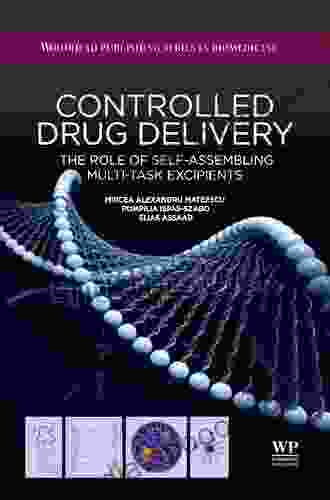Novel Biomaterials and Their Role in Drug Delivery

Biomaterials play a vital role in drug delivery. They can be used to create implantable devices, drug-eluting stents, and other medical devices that can deliver drugs directly to the target site. Biomaterials can also be used to create nanoparticles that can carry drugs through the bloodstream and target specific cells.
The field of biomaterials is constantly evolving, with new materials being developed all the time. These new materials offer a variety of advantages over traditional materials, including improved biocompatibility, reduced toxicity, and enhanced drug delivery efficiency.
5 out of 5
| Language | : | English |
| File size | : | 68123 KB |
| Text-to-Speech | : | Enabled |
| Screen Reader | : | Supported |
| Enhanced typesetting | : | Enabled |
| Print length | : | 608 pages |
Types of Biomaterials
There are many different types of biomaterials that can be used for drug delivery. The most common types include:
- Metals: Metals such as stainless steel, titanium, and nitinol are often used in implantable devices. They are strong and durable, but they can also be toxic if they are not properly coated.
- Polymers: Polymers are organic materials that can be used to create a wide variety of medical devices. They are flexible and biocompatible, but they can be difficult to sterilize.
- Ceramics: Ceramics are inorganic materials that are often used in implantable devices. They are strong and durable, but they can be brittle.
- Natural materials: Natural materials such as collagen, bone, and cartilage are often used in tissue engineering and regenerative medicine. They are biocompatible and biodegradable, but they can be difficult to process.
Properties of Biomaterials
The properties of biomaterials are important for determining their suitability for drug delivery. The most important properties include:
- Biocompatibility: Biocompatibility refers to the ability of a biomaterial to interact with the body without causing any adverse effects. Biocompatible materials do not cause inflammation or other immune reactions.
- Toxicity: Toxicity refers to the ability of a biomaterial to cause harm to the body. Toxic materials can leach metals or other harmful substances into the body.
- Strength and durability: Strength and durability refer to the ability of a biomaterial to withstand stress and deformation. Strong and durable materials are less likely to fail or break down.
- Flexibility: Flexibility refers to the ability of a biomaterial to bend or deform without breaking. Flexible materials are easier to insert into the body and to conform to the shape of the target site.
- Biodegradability: Biodegradability refers to the ability of a biomaterial to break down into harmless substances over time. Biodegradable materials are less likely to cause long-term problems in the body.
Applications of Biomaterials in Drug Delivery
Biomaterials are used in a wide variety of drug delivery applications. The most common applications include:
- Implantable devices: Implantable devices are medical devices that are surgically implanted into the body. They can deliver drugs directly to the target site, which can improve drug efficacy and reduce side effects.
- Drug-eluting stents: Drug-eluting stents are stents that are coated with a drug that is released slowly over time. This helps to prevent restenosis, which is the narrowing of the artery after stent placement.
- Nanoparticles: Nanoparticles are small particles that can be used to carry drugs through the bloodstream and target specific cells. Nanoparticles can be made from a variety of materials, including polymers, metals, and ceramics.
- Tissue engineering and regenerative medicine: Tissue engineering and regenerative medicine are fields that use biomaterials to create new tissues and organs. These tissues and organs can be used to repair damaged tissue or to replace organs that have failed.
Challenges and Future Prospects
The field of biomaterials is constantly evolving, with new materials being developed all the time. However, there are still a number of challenges that need to be overcome before biomaterials can be used in all drug delivery applications. These challenges include:
- Toxicity: Some biomaterials can be toxic if they are not properly coated or processed. This can be a major problem for implantable devices and other long-term applications.
- Biocompatibility: Some biomaterials can cause inflammation or other immune reactions in the body. This can be a problem for tissue engineering and regenerative medicine applications.
- Durability: Some biomaterials are not strong or durable enough for long-term applications. This can be a problem for implantable devices and other applications where the biomaterial is subjected to stress or deformation.
- Cost: Biomaterials can be expensive to develop and manufacture. This can make it difficult to use biomaterials in low-cost healthcare applications.
Despite these challenges, the field of biomaterials is very promising. New materials are being developed all the time, and researchers are making progress in overcoming the challenges that have limited the use of biomaterials in the past. As these challenges are overcome, biomaterials will play an increasingly important role in drug delivery and other medical applications.
Biomaterials play a vital role in drug delivery. They can be used to create implantable devices, drug-eluting stents, and other medical devices that can deliver drugs directly to the target site. Biomaterials can also be used to create nanoparticles that can carry drugs through the bloodstream and target specific cells. The field of biomaterials is constantly evolving, with new materials being developed all the time. These new materials offer a variety of advantages over traditional materials, including improved biocompatibility, reduced toxicity, and enhanced drug delivery efficiency. As the challenges of biomaterials are overcome, they will play an increasingly important role in drug delivery and other medical applications.
5 out of 5
| Language | : | English |
| File size | : | 68123 KB |
| Text-to-Speech | : | Enabled |
| Screen Reader | : | Supported |
| Enhanced typesetting | : | Enabled |
| Print length | : | 608 pages |
Do you want to contribute by writing guest posts on this blog?
Please contact us and send us a resume of previous articles that you have written.
 Book
Book Novel
Novel Page
Page Chapter
Chapter Text
Text Story
Story Genre
Genre Reader
Reader Library
Library Paperback
Paperback E-book
E-book Magazine
Magazine Newspaper
Newspaper Paragraph
Paragraph Sentence
Sentence Bookmark
Bookmark Shelf
Shelf Glossary
Glossary Bibliography
Bibliography Foreword
Foreword Preface
Preface Synopsis
Synopsis Annotation
Annotation Footnote
Footnote Manuscript
Manuscript Scroll
Scroll Codex
Codex Tome
Tome Bestseller
Bestseller Classics
Classics Library card
Library card Narrative
Narrative Biography
Biography Autobiography
Autobiography Memoir
Memoir Reference
Reference Encyclopedia
Encyclopedia Paul R Gregory
Paul R Gregory M Bakri Musa
M Bakri Musa Cressida Mclaughlin
Cressida Mclaughlin Boff Whalley
Boff Whalley Lindsay Jayne Ashford
Lindsay Jayne Ashford Paul Spoonley
Paul Spoonley Dunya Mikhail
Dunya Mikhail Peter Steer
Peter Steer Farooq A Kperogi
Farooq A Kperogi Anne M Beninghof
Anne M Beninghof A C Grayling
A C Grayling Allyson F Creasman
Allyson F Creasman D D Peters
D D Peters Valerie Ogden
Valerie Ogden D C Adams
D C Adams A G Howard
A G Howard Jill Shalvis
Jill Shalvis Mark K Ferguson
Mark K Ferguson 33 Black
33 Black Mark Beaumont
Mark Beaumont
Light bulbAdvertise smarter! Our strategic ad space ensures maximum exposure. Reserve your spot today!

 Clarence MitchellEthnomusicological Encounters: Delving into the Heart and Soul of Music and...
Clarence MitchellEthnomusicological Encounters: Delving into the Heart and Soul of Music and... Dylan HayesFollow ·16.9k
Dylan HayesFollow ·16.9k Ralph EllisonFollow ·18.7k
Ralph EllisonFollow ·18.7k George R.R. MartinFollow ·8.7k
George R.R. MartinFollow ·8.7k Clinton ReedFollow ·8.2k
Clinton ReedFollow ·8.2k Kevin TurnerFollow ·5.2k
Kevin TurnerFollow ·5.2k Wayne CarterFollow ·7.4k
Wayne CarterFollow ·7.4k Stephen KingFollow ·7.7k
Stephen KingFollow ·7.7k Evan HayesFollow ·11.2k
Evan HayesFollow ·11.2k

 Jacob Hayes
Jacob HayesUnlock the Power of Microsoft Word: A Comprehensive Guide...
Microsoft Word is a widely used word...

 Hunter Mitchell
Hunter MitchellAndrea Carter and the Price of Truth: A Thrilling...
Get ready for an unforgettable...

 Ivan Turner
Ivan TurnerTrading Jeff and His Dog: An Unforgettable Adventure of...
Get ready for an emotional rollercoaster...

 Langston Hughes
Langston HughesGo Viral TikTok: The Ultimate Guide to Gaining 100K...
TikTok has emerged as a social...

 Ibrahim Blair
Ibrahim BlairUnveil the Enchanting Realm of Short Fiction: Dive into...
Delve into a Literary Tapestry of...

 Tennessee Williams
Tennessee WilliamsUnveil the Enchanting World of Elizabeth Barrett...
A Poetic Tapestry of Love, Loss, and...
5 out of 5
| Language | : | English |
| File size | : | 68123 KB |
| Text-to-Speech | : | Enabled |
| Screen Reader | : | Supported |
| Enhanced typesetting | : | Enabled |
| Print length | : | 608 pages |










